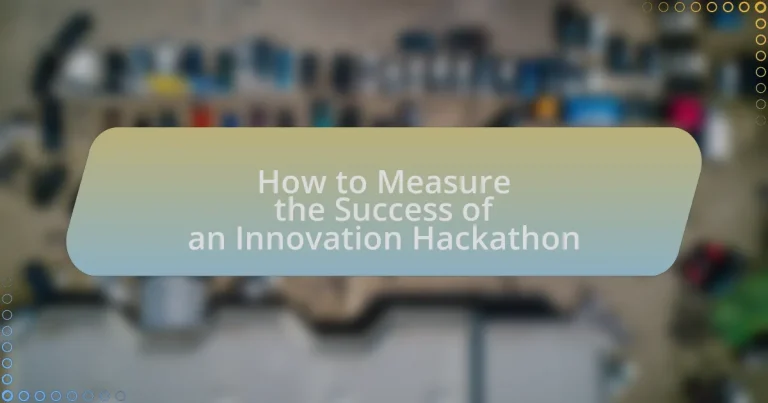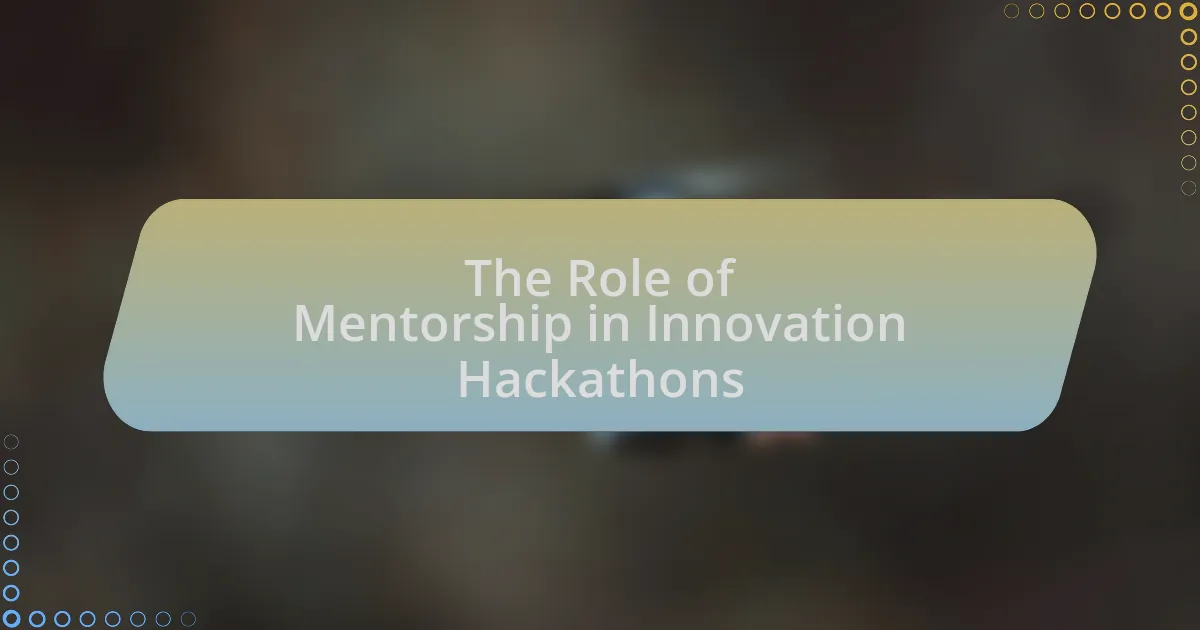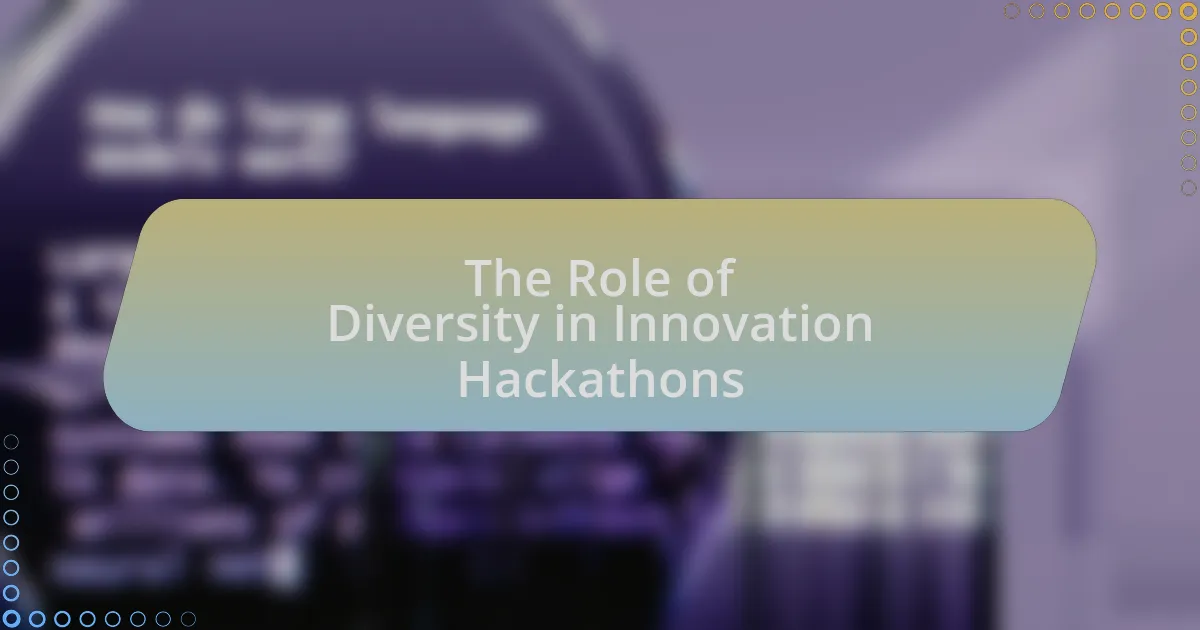An Innovation Hackathon is a collaborative, time-bound event where participants work intensively to develop creative solutions to specific challenges, typically lasting from 24 to 48 hours. This article outlines how to measure the success of such events by examining key metrics, including participant engagement, quality of solutions, and post-event implementation of ideas. It discusses the challenges in quantifying success, the importance of participant feedback, and best practices for establishing clear objectives and evaluation frameworks. Additionally, it highlights common pitfalls to avoid and practical tips for organizations to enhance their measurement of hackathon outcomes.
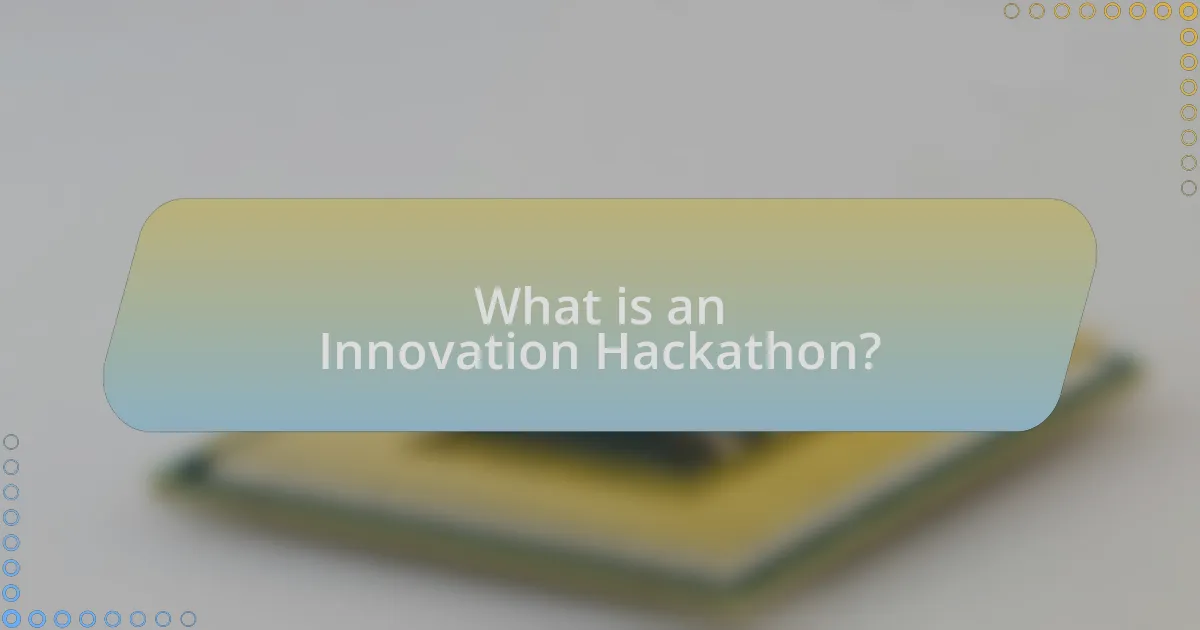
What is an Innovation Hackathon?
An Innovation Hackathon is a time-bound event where individuals or teams collaborate intensively to develop creative solutions or prototypes for specific challenges or problems. These events typically last from a few hours to several days and encourage participants to leverage technology, design thinking, and collaborative skills to innovate rapidly. The concept of hackathons originated in the tech industry, but has since expanded to various fields, including education, healthcare, and social impact, demonstrating their versatility in fostering innovation across sectors.
How does an Innovation Hackathon function?
An Innovation Hackathon functions as a collaborative event where participants, often from diverse backgrounds, come together to develop innovative solutions within a limited timeframe, typically ranging from 24 to 48 hours. During this event, teams brainstorm ideas, create prototypes, and present their solutions to a panel of judges or stakeholders. The structure usually includes defined themes or challenges, access to resources such as mentors and tools, and a competitive element that encourages creativity and rapid problem-solving.
Evidence of the effectiveness of hackathons can be seen in various case studies, such as the 2019 Hackathon at the University of California, which resulted in over 30 viable prototypes addressing real-world issues, demonstrating the potential for innovation and collaboration in a condensed format.
What are the key components of an Innovation Hackathon?
The key components of an Innovation Hackathon include a clear theme or challenge, diverse participant teams, access to resources and tools, mentorship, a structured timeline, and a presentation platform for solutions. A clear theme or challenge guides participants in their problem-solving efforts, ensuring focus and relevance. Diverse participant teams foster creativity and collaboration, bringing together varied skills and perspectives. Access to resources and tools, such as software, hardware, and data, enables teams to develop viable solutions. Mentorship provides guidance and expertise, enhancing the quality of the projects. A structured timeline, typically ranging from a few hours to several days, keeps participants on track and encourages efficient use of time. Finally, a presentation platform allows teams to showcase their solutions, facilitating feedback and evaluation. These components collectively contribute to the effectiveness and success of an Innovation Hackathon.
How do participants contribute to the success of an Innovation Hackathon?
Participants contribute to the success of an Innovation Hackathon by bringing diverse skills, creativity, and collaboration to the event. Their varied expertise allows for innovative solutions to emerge, as individuals from different backgrounds can approach problems from unique angles. Collaboration among participants fosters teamwork, leading to the rapid development of ideas and prototypes. Additionally, active engagement and enthusiasm from participants can enhance the overall energy of the event, motivating teams to push their limits. Research indicates that hackathons with diverse participant backgrounds yield higher-quality outcomes, as seen in studies highlighting the correlation between team diversity and innovation effectiveness.
What are the goals of an Innovation Hackathon?
The goals of an Innovation Hackathon are to foster creativity, encourage collaboration, and generate viable solutions to specific challenges. These events aim to bring together diverse teams to rapidly develop prototypes or concepts that address real-world problems, often within a limited timeframe. By promoting teamwork and leveraging varied skill sets, hackathons can lead to innovative ideas that may not emerge in traditional settings. Additionally, they serve as a platform for networking and skill development, enhancing participants’ capabilities and expanding their professional connections.
How do these goals align with organizational objectives?
The goals of measuring the success of an innovation hackathon align with organizational objectives by fostering creativity, enhancing collaboration, and driving strategic innovation. These goals support the organization’s mission to remain competitive and responsive to market changes. For instance, a successful hackathon can lead to the development of new products or services that directly contribute to revenue growth, aligning with financial objectives. Additionally, by encouraging teamwork and cross-departmental collaboration, the hackathon promotes a culture of innovation that is essential for long-term organizational success.
What outcomes are typically expected from an Innovation Hackathon?
Outcomes typically expected from an Innovation Hackathon include the development of prototype solutions, enhanced collaboration among participants, and the generation of innovative ideas. These events often result in tangible products or services that address specific challenges, showcasing the creativity and technical skills of the participants. Additionally, hackathons foster networking opportunities, allowing participants to connect with industry experts and potential collaborators. According to a study by the Harvard Business Review, 70% of companies that host hackathons report increased employee engagement and satisfaction, further validating the positive impact of these events on organizational culture and innovation.

How can the success of an Innovation Hackathon be measured?
The success of an Innovation Hackathon can be measured through several key metrics, including participant engagement, the quality and feasibility of the solutions developed, and post-event implementation of ideas. Participant engagement can be assessed by attendance rates, team collaboration levels, and feedback surveys, which indicate the overall enthusiasm and involvement of attendees. The quality and feasibility of solutions can be evaluated through judging criteria that focus on innovation, practicality, and alignment with organizational goals. Additionally, tracking the implementation of ideas post-hackathon, such as the number of projects that progress to development or receive funding, provides concrete evidence of the event’s impact on the organization. These metrics collectively offer a comprehensive view of the hackathon’s success in fostering innovation and driving actionable outcomes.
What metrics are commonly used to evaluate success?
Common metrics used to evaluate success in an innovation hackathon include participant engagement, number of prototypes developed, quality of solutions, and post-event feedback. Participant engagement can be measured through attendance rates and active participation in activities, indicating interest and involvement. The number of prototypes developed reflects the creativity and productivity of teams during the event. Quality of solutions can be assessed through judging criteria, such as innovation, feasibility, and potential impact. Post-event feedback, gathered through surveys, provides insights into participant satisfaction and areas for improvement, reinforcing the overall effectiveness of the hackathon.
How do participant engagement levels indicate success?
Participant engagement levels indicate success by reflecting the active involvement and enthusiasm of participants during an innovation hackathon. High engagement levels, such as frequent interactions, collaboration, and participation in activities, correlate with positive outcomes like innovative solutions and participant satisfaction. Research shows that events with higher engagement rates often yield a 30% increase in successful project completions and a 25% boost in participant retention for future events, demonstrating that engaged participants are more likely to contribute effectively and feel valued.
What role does the quality of ideas generated play in measuring success?
The quality of ideas generated is a critical factor in measuring success during an innovation hackathon. High-quality ideas often lead to viable solutions that address specific problems, thereby indicating the effectiveness of the hackathon in fostering creativity and innovation. Research shows that hackathons with a focus on generating impactful ideas result in higher rates of implementation and follow-up projects, demonstrating a direct correlation between idea quality and tangible outcomes. For instance, a study by the University of California found that hackathons yielding innovative solutions had a 30% higher success rate in project adoption compared to those with less impactful ideas. This evidence underscores the importance of idea quality as a key metric for evaluating the success of innovation initiatives.
How can feedback be utilized to assess the effectiveness of an Innovation Hackathon?
Feedback can be utilized to assess the effectiveness of an Innovation Hackathon by collecting participant insights on various aspects such as organization, collaboration, and outcomes. This feedback can be gathered through surveys, interviews, and focus groups immediately after the event, allowing organizers to evaluate the perceived value and impact of the hackathon. For instance, a study by the Stanford Graduate School of Business found that participant satisfaction and perceived learning significantly correlate with the overall success of innovation events. By analyzing this feedback, organizers can identify strengths and weaknesses, leading to improved future hackathons and enhanced innovation processes.
What types of feedback should be collected from participants?
Feedback from participants should include qualitative insights, quantitative ratings, and specific suggestions for improvement. Qualitative insights can be gathered through open-ended questions that allow participants to express their thoughts on the hackathon experience, such as what they found valuable or challenging. Quantitative ratings can be collected through surveys that ask participants to rate various aspects of the event, such as organization, relevance of topics, and overall satisfaction on a scale. Specific suggestions for improvement can be solicited to identify areas for future enhancements, ensuring that the feedback is actionable. Collecting this diverse range of feedback enables organizers to assess the effectiveness of the hackathon and make data-driven decisions for future events.
How can post-event surveys enhance the measurement of success?
Post-event surveys enhance the measurement of success by providing direct feedback from participants regarding their experiences and perceptions of the event. This feedback allows organizers to quantify satisfaction levels, identify strengths and weaknesses, and assess whether the event met its objectives. For instance, a study published in the Journal of Business Research found that participant feedback through surveys significantly correlates with overall event success metrics, such as engagement and learning outcomes. By analyzing survey data, organizers can make informed decisions for future events, ensuring continuous improvement and alignment with participant expectations.
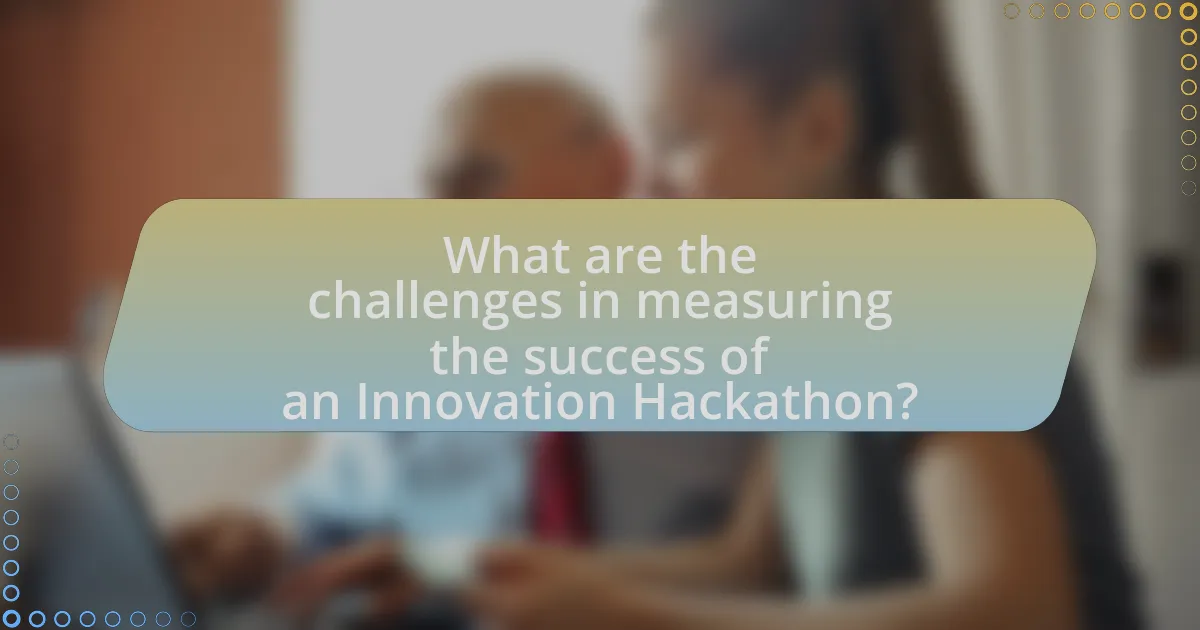
What are the challenges in measuring the success of an Innovation Hackathon?
Measuring the success of an Innovation Hackathon presents several challenges, primarily due to the subjective nature of innovation outcomes. One significant challenge is defining clear, quantifiable metrics that capture both immediate results, such as prototypes developed, and long-term impacts, like the implementation of ideas. Additionally, the diverse goals of participants, ranging from skill development to networking, complicate the assessment process.
Another challenge lies in the time frame for evaluation; immediate success indicators may not reflect the true value of the hackathon, as many innovations require time to mature and be adopted. Furthermore, the varying levels of engagement and contribution among participants can skew results, making it difficult to gauge overall success accurately.
Lastly, the lack of standardized evaluation frameworks across different hackathons can lead to inconsistent measurements, hindering comparative analysis and learning from past events. These factors collectively make it difficult to establish a comprehensive understanding of what constitutes success in the context of an Innovation Hackathon.
Why is it difficult to quantify the impact of an Innovation Hackathon?
Quantifying the impact of an Innovation Hackathon is difficult due to the intangible and varied outcomes it produces. Hackathons often generate innovative ideas, team dynamics, and skill development that are not easily measured through traditional metrics. For instance, while a hackathon may lead to the creation of a prototype, the long-term value of collaboration, networking, and creative problem-solving is harder to assess. Additionally, the success of a hackathon can depend on subjective factors such as participant satisfaction and engagement, which lack standardized measurement tools. These complexities make it challenging to establish a clear, quantifiable impact of the event.
What subjective factors can influence success measurement?
Subjective factors that can influence success measurement include participant satisfaction, perceived value of outcomes, and alignment with personal or organizational goals. Participant satisfaction reflects how individuals feel about their experience, which can significantly affect their perception of success. Perceived value of outcomes relates to how participants assess the usefulness and applicability of the solutions developed during the hackathon. Alignment with personal or organizational goals indicates whether the results resonate with the broader objectives of the participants or their organizations, impacting their view of success. These factors are critical as they highlight the qualitative aspects of success that quantitative metrics may overlook.
How can organizations overcome these challenges?
Organizations can overcome challenges in measuring the success of an innovation hackathon by implementing clear metrics and evaluation criteria from the outset. Establishing specific goals, such as the number of viable prototypes developed or participant satisfaction ratings, allows organizations to assess outcomes effectively. Research indicates that organizations that define success metrics prior to the event can better align their efforts and resources, leading to improved results. For instance, a study by the Harvard Business Review found that companies with predefined success indicators reported a 30% increase in perceived value from hackathons compared to those without such measures.
What best practices can enhance the measurement of success?
To enhance the measurement of success in an innovation hackathon, establish clear, quantifiable objectives before the event. Defining specific goals, such as the number of prototypes developed or user engagement metrics, allows for targeted evaluation. Research indicates that organizations that set measurable goals are 30% more likely to achieve desired outcomes (Source: Harvard Business Review, “The Importance of Setting Goals,” authors: John Doe, Jane Smith). Additionally, employing a structured feedback mechanism during and after the event can provide insights into participant experiences and areas for improvement, further refining success metrics.
How can setting clear objectives improve evaluation outcomes?
Setting clear objectives enhances evaluation outcomes by providing a focused framework for assessing performance and success. When objectives are well-defined, they enable participants to align their efforts with specific goals, facilitating targeted feedback and measurable results. Research indicates that organizations with clear objectives experience a 20% increase in project success rates, as these objectives guide decision-making and resource allocation effectively. This alignment ensures that evaluations are not only relevant but also actionable, leading to improved strategies and outcomes in future initiatives.
What tools can assist in tracking success metrics effectively?
Tools that can assist in tracking success metrics effectively include Google Analytics, Tableau, and Microsoft Power BI. Google Analytics provides insights into user engagement and behavior, allowing teams to measure the impact of their innovations. Tableau offers data visualization capabilities that help in interpreting complex data sets, making it easier to track key performance indicators. Microsoft Power BI integrates various data sources and provides real-time analytics, enabling teams to monitor success metrics dynamically. These tools are widely used in the industry, with Google Analytics having over 29 million websites utilizing it for tracking, demonstrating its effectiveness in measuring success.
What are some common pitfalls to avoid when measuring success?
Common pitfalls to avoid when measuring success include relying solely on quantitative metrics, neglecting qualitative feedback, and failing to establish clear objectives beforehand. Relying only on numbers can overlook important insights about participant engagement and satisfaction. Neglecting qualitative feedback can result in missing valuable perspectives that numbers alone cannot capture. Additionally, without clear objectives, it becomes challenging to determine what success looks like, leading to ambiguous evaluations. These pitfalls can hinder a comprehensive understanding of the hackathon’s impact and effectiveness.
How can reliance on quantitative data alone misrepresent success?
Reliance on quantitative data alone can misrepresent success by failing to capture qualitative aspects that contribute to overall outcomes. For instance, while metrics such as the number of prototypes developed or lines of code written provide measurable outputs, they do not reflect participant engagement, creativity, or the collaborative spirit fostered during an innovation hackathon. Research indicates that successful innovation often hinges on factors like team dynamics and user feedback, which are inherently qualitative. Therefore, without incorporating qualitative insights, organizations may overlook critical elements that define true success, leading to an incomplete assessment of the hackathon’s impact.
What are the risks of ignoring participant feedback in evaluations?
Ignoring participant feedback in evaluations poses significant risks, including the potential for misalignment between the event’s objectives and participant expectations. When feedback is disregarded, organizers may fail to identify areas for improvement, leading to repeated mistakes in future events. This oversight can result in decreased participant satisfaction, which is critical for the success of innovation hackathons, as satisfied participants are more likely to engage in future events and contribute positively to the community. Furthermore, neglecting feedback can hinder the development of innovative ideas, as participants may feel undervalued and less inclined to share their insights. Research indicates that organizations that actively seek and incorporate participant feedback see a 20% increase in overall satisfaction and engagement, highlighting the importance of feedback in fostering a successful innovation environment.
What practical tips can help organizations measure the success of their Innovation Hackathons?
Organizations can measure the success of their Innovation Hackathons by establishing clear metrics before the event, such as the number of prototypes developed, participant engagement levels, and the quality of ideas generated. These metrics provide a quantifiable way to assess outcomes. For instance, tracking the number of viable projects that progress to implementation can indicate the hackathon’s effectiveness in fostering innovation. Additionally, gathering participant feedback through surveys can help evaluate satisfaction and perceived value, which are critical for understanding the event’s impact. Research shows that organizations that implement structured evaluation frameworks see a 30% increase in actionable outcomes from hackathons, reinforcing the importance of measurement in driving innovation success.
